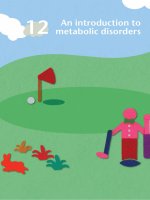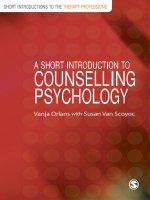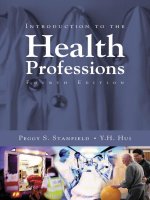Introduction to chemistry course
Bạn đang xem bản rút gọn của tài liệu. Xem và tải ngay bản đầy đủ của tài liệu tại đây (4.68 MB, 58 trang )
Chemistry Preliminary Course 2011.
Dr Mike Lyons
School of Chemistry
Trinity College Dublin.
INTRODUCTION TO
CHEMISTRY.
Chemistry Preliminary Course 2011
12/09/2011
1
Dr Mike Lyons
Room 3.2
School of Chemistry
Trinity College
Email:
Chemistry Preliminary Course 2011
12/09/2011
2
Welcome to CHEMISTRY !!!
An Observational Science
An Experimental Science
A Laboratory Science
An Interesting Science
An Important Science
A ―Hard‖ Science
A science rooted in the real world !
Chemistry Preliminary Course 2011
12/09/2011
3
What is chemistry?
Chemistry is the science which deals
with the composition and properties of
material substances, and the reactions
by which one substance is converted
into another.
Chemistry is a core science and along
with Physics and Biology provides an
understanding of the material universe.
Chemistry Preliminary Course 2011
12/09/2011
4
Chemistry as the Central Science
Oceanography
Atmospheric
Sciences
Physics
Economics
Medicine
Governments
Chemistry
Advanced
Materials
Geology
Archeology
People
Biology
Politics
Astronomy
Chemistry Preliminary Course 2011
12/09/2011
5
Chemistry …the experimental science
Chemistry Preliminary Course 2011
12/09/2011
6
Chemistry Preliminary Course 2011
12/09/2011
7
Chemistry .. Is a social activity..science distributed via human interaction
Chemistry Preliminary Course 2011
12/09/2011
8
Chemistry: the major subject areas.
Physical Chemistry.
Organic Chemistry.
Inorganic Chemistry.
Analytical Chemistry.
Biochemistry.
Environmental
Chemistry.
Medicinal Chemistry.
Computational
Chemistry.
Materials Chemistry.
Chemical Physics.
Biological Chemistry.
Many of these topics
will be studied in the
Chemistry course at
Trinity.
At the research level,
chemists may work in
more than one of these
areas, and may be
involved in research
programmes straddling
disciplines such as
physics and molecular
biology.
Chemistry Preliminary Course 2011
12/09/2011
9
The scientific method…
…. The best baloney
detector there is …
Use scientific method to
distinguish Between science
and pseudo-science.
1. Define/Identify the Problem .
2. Form a Hypothesis .
3. Make Observations or Test
Hypothesis and Perform Experiments.
4. Organize and Analyze Data.
5. Do Experiments and Observations
Support Hypothesis?
If No, Perform New Experiments
and Repeat Step 4
6. Draw Conclusions
7. Communicate Results
Chemistry Preliminary Course 2011
12/09/2011
10
Science vs Faith :
Non Overlapping Magisteria or Mutually Exclusive Worldviews ?
Chemistry Preliminary Course 2011
12/09/2011
11
S.J. Gould (NOMA) Hypothesis:
science and religion occupy nonoverlapping magisteria (NOMA) – i.e.
that each rules over its own domain and
as such cannot be in conflict.
Gould addresses the conflict between secular
scientists and religious believers who question or
deny scientific theory when it is in discrepancy with
religious teachings on the origin and nature of the
natural world. Borrowing a term from the Catholic
Church, Gould describes science and religion as each
comprise a separate magisterium of human
understanding. Science defines the natural world,
and religion the moral world. If each realm is
separate, then according to Gould, they are not in
conflict. He calls this the principle of nonoverlapping magisteria, abbreviated NOMA.
Science tries to document the factual
character of the natural world, and to develop
theories that coordinate and explain these
facts. Religion, on the other hand, operates on
the equally important, but utterly different,
realm of human purposes, meanings and values - subjects that the factual domain of science
might illuminate, but can never resolve. ~
Stephen Jay Gould
Science deals with ‗how‘ questions.
Faith deals with ‗why‘ questions.
Chemistry Preliminary Course 2011
12/09/2011
12
Whatever else they may say, those scientists who subscribe to the 'separate magesteria'
school of thought should concede that the universe with a supernaturally intelligent creator
is a very different kind of universe from one without. The difference between the two
hypothetical universes could hardly be more fundamental in principle, even if it is not easy to
test in practice. And it undermines the dictum that science must be completely silent about
religion's central existence claim. The presence or absence of a creative super-intelligence is
unequivocally a scientific question, even if not in practice -- or not yet -- a decided one. ~
Richard Dawkins
When faced with miracle stories, Gould would presumably retort along the following lines.
The whole point of NOMA is that it is a two-way bargain. The moment religion steps on
science's turf and starts to meddle in the real world with miracles, it ceases to be religion
in the sense that Gould is defending, and his amcabilis concordia is broken. Note, however,
that miracle-free religion defended by Gould would not be recognized by most practicing
theists in the pew or on the prayer mat. It would, indeed, be a grave disappointment to
them. ~ Richard Dawkins
Chemistry Preliminary Course 2011
12/09/2011
13
The learned fool writes his nonsense in better language
than the unlearned, but still 'tis nonsense. ~ Benjamin
Franklin
The very notion of physical law is a theological one in
the first place, a fact that makes many scientists
squirm. Isaac Newton first got the idea of absolute,
universal, perfect, immutable laws from the Christian
doctrine that God created the world and ordered it
in a rational way. ~ Paul Davies
Chemistry Preliminary Course 2011
Bottom Line :
Mutual Respect.
12/09/2011
14
Is ‗Creation Science‘ Science
or pseudoscience?
/> /> /> />
A pseudoscience is any body of alleged
knowledge, methodology, belief,
or practice that claims to be scientific but
does not follow the scientific method.
A pseudoscience is an established body of
knowledge which masquerades as science
in an attempt to claim a legitimacy which it
would not otherwise be able to achieve on its own
terms.
The most important of its defects is usually
the lack of the carefully controlled and thoughtfully
interpreted experiments which provide the foundation
of the natural sciences and which contribute to
their advancement.
Chemistry Preliminary Course 2011
12/09/2011
15
Pathological Science
•N Rays
•Polywater
•Cold Fusion
Personal enthusiasm takes precedence over
peer review.
Junk Science
Term often used to describe scientific theories or data which,
while perhaps legitimate in themselves, are believed to be
mistakenly used to support an opposing position.
•Political ideological bias in presentation of data.
•Commercial advertising.
Chemistry Preliminary Course 2011
12/09/2011
16
The atom concept.
The underlying concept of atoms as the basic building blocks of matter
has been around for a long time.
As early as 600 BCE, the Gujarati (Indian) philosopher Acharya Kanad
wrote that "Every object of creation is made of atoms which in turn
connect with each other to form molecules".
A couple of centuries later in 460 BCE, the Greek philosopher Democritus
reasoned that if you keep breaking a piece of matter into smaller and
smaller fragments, there will be some point at which the pieces cannot
be made any smaller.
He called these "basic matter particles"— in other words, atoms.
But this was just philosophy; it would not be until 1800 when John Dalton
showed how the atomic concept followed naturally from the results of
quantitative experiments based on weight measurements.
Chemistry Preliminary Course 2011
12/09/2011
17
The components of matter.
Matter is the ‗stuff‘ of the universe
: books, trees, students etc. It has
mass and volume.
Modern chemistry is based on the
atomic theory of matter.
The fundamental unit of a chemical
substance is called an atom.
Atoms combine to make all
substances in the world around us.
A molecule is a combination of two
or more atoms held together in a
specific shape by attractive forces
called chemical bonds.
Each different type of atom
is called an element. At
present there are 109
elements. Elements cannot be
decomposed into simpler
substances.
A chemical compound is a
substance that contains more
than one element. The
relative amounts of each
element in a particular
compound do not change.
Every molecule of a particular
chemical substance contains a
characteristic number of
atoms of its constituent
elements.
Chemistry Preliminary Course 2011
12/09/2011
18
Development of the element concept.
The concept of the element is an ancient one which developed in
many different civilizations in an attempt to rationalize the
variety of the world and to understand the nature of change,
such as that which occurs when a piece of wood rots,
or is burnt to produce charcoal or ash.
Most well known to us are the four elements "earth, air, fire and water"
that were popularized by Greek philosophers
(principally Empedocoles and Aristotle) in the period 500-400 BCE.
To these, Vedic (Hindu) philosophers of India added space,
while the ancient Chinese concept of Wu Xing regarded earth, metal,
wood, fire and water as fundamental.
Chemistry Preliminary Course 2011
12/09/2011
19
These basic elements were not generally
considered to exist
as the actual materials we know as
earth, water, etc., but rather
to represent the principles or essences
that the elements conveyed to the
various kinds of matter we encounter in
the world.
Eventually, practical experience (largely connected with the
extraction of metals from ores) and the beginnings of
scientific experimentation in the 18th Century led to our
modern concept of the element:
An element is the simplest form to which any other chemical substance
can be reduced through appropriate thermal or chemical treatment.
Chemistry Preliminary Course 2011
12/09/2011
20
Antoine-Laurent
Lavoisier
1743-1794
Traitè Èlèmentaire de Chemie
1789
Chemistry Preliminary Course 2011
12/09/2011
21
Definitions for Components of Matter
Element - the simplest type of substance with
unique physical and chemical properties. An element
consists of only one type of atom. It cannot be
broken down into any simpler substances by physical
or chemical means.
Molecule - a structure that consists of two or
more atoms which are chemically bound together
and thus behaves as an independent unit.
Compound - a substance composed of two or
more elements which are chemically combined.
Mixture - a group of two or more elements and/or
compounds that are physically intermingled.
Chemistry Preliminary Course 2011
12/09/2011
22
Heterogeneous mixtures : has one or
more visible boundaries between the
components.
Homogeneous mixtures : has no visible
boundaries because the components are
mixed as individual atoms, ions, and
molecules.
Solutions : A homogeneous mixture is
also called a solution.
Solutions in water are called aqueous
solutions, and are very important in
chemistry. Although we normally think
of solutions as liquids, they can exist in
all three physical states.
Chemistry Preliminary Course 2011
FeS
12/09/2011
23
Chemistry Preliminary Course 2011
12/09/2011
24
While chemical weapons were nothing new to
war, World War I was the first time that
they figured prominently in battle strategy.
They were used by both sides, to varying
degrees.
In late 1914, German scientist Fritz Haber
came up with the idea of creating a cloud of
poison gas by using thousands of cylinders
filled with chlorine. Deployed in April 1915
during the battle for Ypres, France, the
attack might have broken the Allied lines if
German troops understood how to follow up
the gas attack.
By late 1915, Allied troops made their own
chorine gas attacks. It led to a race for more
and more toxic chemicals. Germany came up
with diphosgene gas; the French tried
cyanide gas.
‗Gassed‘
John Singer Sargent
In July 1917, Germany introduced mustard
gas, which burned the skin as well as the
lungs.
Biological warfare was generally less
successful. Most of these efforts focused on
infecting enemy livestock with anthrax or
glanders.
Chemistry Preliminary Course 2011
12/09/2011
25









